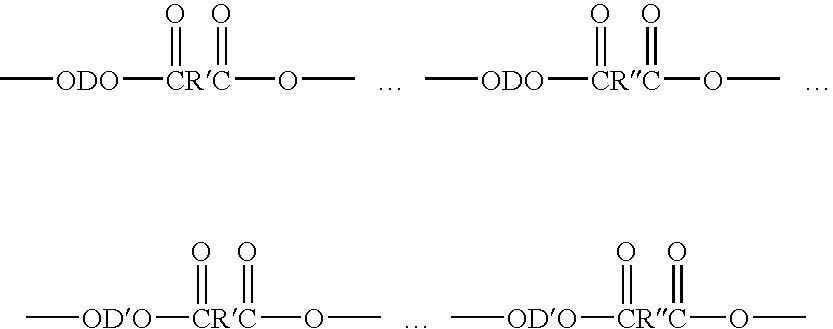Copolyetheresters derived from polyethylene terephthalate
a polyethylene terephthalate and polyethylene ether technology, applied in the direction of dyeing process, plastic recycling, textiles and papermaking, etc., can solve the problems of significant waste of pet waste, significant resource that could be used more effectively, and incineration of pet was
- Summary
- Abstract
- Description
- Claims
- Application Information
AI Technical Summary
Benefits of technology
Problems solved by technology
Method used
Image
Examples
examples 9-13
[0179] These examples show polytrimethylene terephthalate (PTT) elastomers being made. Green colored recycle PET pellets were obtained from St. Jude, a supplier in North America and clear recycle PET pellets were obtained from a supplier in India. The poly(tetrahydrofuran) (pTHF) was obtained from BASF and had a nominal molecular weight of 1000 g / mol. The post consumer recycle PET pellets had an IV specification of 0.68 to 0.78 and a melting temperature specification of 245 to 255 C. The 1,3-propanediol (PDO) was obtained from Shell Chemicals and had a purity specification of >99.9 wt. %. The TPT catalyst was commercial Tyzor grade available from Dupont.
example 9
[0180] 44.67 grams of green colored recycle PET pellets were mixed with 35 grams of 1,3-propanediol and 50 grams of pTHF (molar ratio of reactive end groups 1:2:0.2) in a 500 ml reaction kettle. The temperature of the oil bath (for the reaction kettle) was ramped up from 180 to 255 C. The agitator speed was set at 20 rpm. At this stage, 0.07 ml of TPT catalyst was also added to the reaction mix. The reaction mass achieved a temperature of 214 C (boiling point of 1,3-propanediol) and the PDO was refluxed at this temperature for 2 hours. This is referred to as the PET glycolysis stage.
[0181] For the poly stage, the reflux condenser was removed and a vacuum was applied to the reaction kettle. The excess diol and other volatile fractions were collected in a ‘Dean and Stark’ condenser. The speed of the agitator was increased to 220 rpm. A vacuum pump was used to reduce the pressure at 40 Torr / min to 0.15 Torr. The increase in molecular weight of the polymer mass was monitored by the inc...
example 10
[0182] 126.48 g of recycle PET pellets were mixed with 120 g of PDO and 15.52 g of pTHF 1000 in a 500 ml 3 neck round bottom flask with the common set up for the ester interchange portion of a melt polymerization (mechanical overhead stirrer and Dean-Starke apparatus). The temperature of the oil bath (for the reaction flask) was 225° C. At this stage, 0.17 ml of TPT catalyst was added to the reaction mixture. The oil bath was held at this temperature for 2 hours. The agitator speed was set at 20 rpm and later increased to 260 rpm when the reaction was homogeneous. This is known as the PET glycolysis stage. After 2 hours, the oil bath temperature was then increased to 250° C. for 1 hour to further drive off any ethylene glycol liberated and to remove most of the excess PDO.
[0183] For the poly stage, the Dean-Starke apparatus was removed and a vacuum was applied to the reaction flask. The pressure was reduced at 40 Torr / min to below 1 Torr. The excess PDO and other volatile fractions...
PUM
| Property | Measurement | Unit |
|---|---|---|
| Temperature | aaaaa | aaaaa |
| Temperature | aaaaa | aaaaa |
| Temperature | aaaaa | aaaaa |
Abstract
Description
Claims
Application Information
 Login to View More
Login to View More - R&D
- Intellectual Property
- Life Sciences
- Materials
- Tech Scout
- Unparalleled Data Quality
- Higher Quality Content
- 60% Fewer Hallucinations
Browse by: Latest US Patents, China's latest patents, Technical Efficacy Thesaurus, Application Domain, Technology Topic, Popular Technical Reports.
© 2025 PatSnap. All rights reserved.Legal|Privacy policy|Modern Slavery Act Transparency Statement|Sitemap|About US| Contact US: help@patsnap.com



